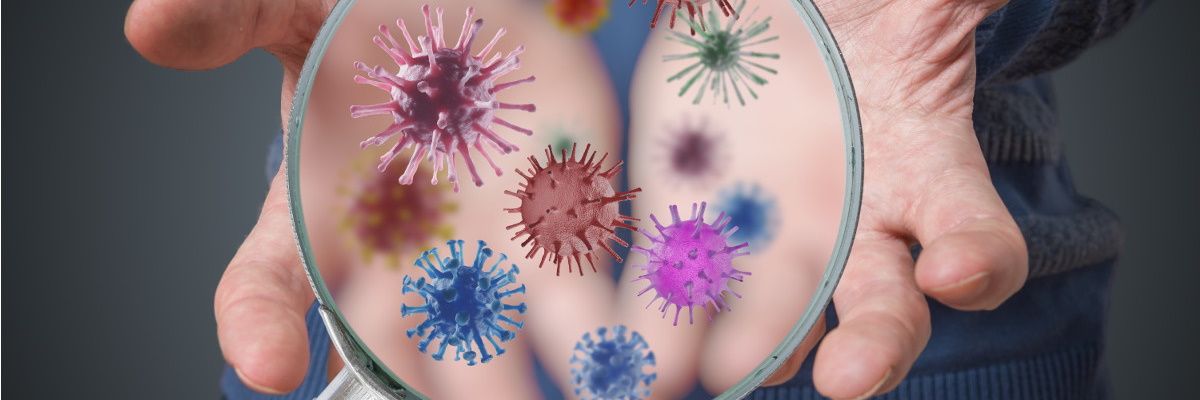
Germs are everywhere, we all know that, and this cannot be avoided. They live in the air, soil, water, food, plants, animals and any other surface, even our bodies. Every workplace will harbour billions of germs, and because we all touch numerous surfaces at work during the day, it is highly likely that germs will spread around fast.
Most of the germs are harmless, and some bacteria are even essential to our survival. There are however those that can throw our bodies out of balance or seriously weaken our immune system, leading to all kinds of illnesses. The most common among them are the stomach and common flu viruses, and bacteria such as Staphyloccocus (Staph), Salmonella and Escherichia coli (E. coli).
Much research has been conducted by a number of institutions across the globe to discover which surfaces in the workplace harbour most germs, that are very often the culprits of absenteeism at work and reduced productivity.
The most obvious frequently touched surfaces, as you may have guessed were door handles, light switches, phones and office equipment. However, you would be surprised to learn that germs have been teaming up in even larger numbers on other surfaces that are oftentimes overlooked.
DESKTOPS

Items such as keyboards, computer mice and phones are getting a lot of attention, and with good reasons, these high-touch surfaces are infested with bacteria. But what about the desktop surface itself?
A research has found that the average desk harbours 100 times more bacteria than a kitchen table and 400 times more bacteria than the average toilet seat. The area where you rest your hand on your desk has, on average, more than 10 million bacteria.
Most of the bacteria found on desk surfaces live on our skin, mouths and nasal passages, so it is most likely they will come off your hands or be expelled while talking, coughing and sneezing. Others, on the other hand, will come from your environment, things you have touched on your way to work, from your co-workers, but also from the lunch you have had at your desk.
| TIP | The bacteria level on the desktop is high simply because the desktops are not being cleaned regularly. Encourage your staff to keep their desks tidy so they can be cleaned properly on the next scheduled clean. Paperwork stacked on the desk is not going to be moved during cleaning, rather only the accessible surfaces will be addressed. It is recommended to have the desks cleaned at least once a week. Boardroom tables and reception should be cleaned daily. |
CARPET
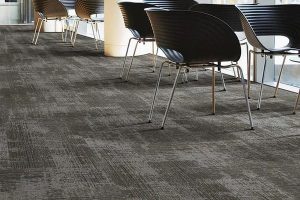
Bacteria thrive on dead skin cells, and the average person sheds about 1.5 million of them every hour. Adding to this soil from your shoes, food crumbs and other bits, this turns easily into a lavish feast for the germs.
A study has revealed that the average carpet will contain over 31 000 bacteria per square centimetre. The mould, bacteria, dust, lead, dust mites and other chemical and biological contaminants become airborne when the carpet is disturbed and can cause severe respiratory problems.
| TIP | Daily vacuuming of high traffic areas is a good way to go, however the vacuum cleaner will not be able to extract all the germs that have settled deep down into the carpet. This can be solved with carpet steam cleaning at least once a year. For large workplaces and schools, it is recommended to practice steam cleaning quarterly, or at the end of each school term. |
KITCHEN TAP

The kitchen is another hotbed for germs and surprisingly, hosts even more faecal bacteria than the bathroom. The reason is that the kitchen is a very busy food preparation area used by all the employees, multiple times during the day.
The kitchen sink and tap are admittedly the biggest germ hoarders. Tap handles are one of the most frequently touched surfaces in the kitchen and sinks easily become a breeding ground for harmful bacteria that feast on the food from the dishes left to soak in the sink.
Another secret hiding place for bacteria, however, one that we rarely think about, is the faucet spigot. The tiny metal aeration screen at the end of the tap is hardly ever cleaned and is continually amassing germs from any physical contact and the dirt splashing back into the spigot when washing food, hands, or dishes. And what’s more, because this area is almost constantly moist, it provides perfect conditions for the bacteria to go wild.
| TIP | Rinsing the sink and tap only with water is not going to remove built-up bacteria. It is recommended that every employee washes their dishes after each meal with soapy water or loads them into the dishwasher. The sink and the tap must be thoroughly washed and sanitised at the end of each workday to maintain hygienic conditions and contribute to the health of the workforce. |
COFFEE MACHINE AND COFFEE POT

Nearly three out of four Australians drink at least one cup of coffee per day, and 23% of them will enjoy 3 or more cups of coffee daily. For many employees, the office coffee machine will be the first stop on the way to their workstations. So, how many fingers a day will touch the pot handle and the start button in your workplace? And what other surfaces did these fingers touch on their way to the coffee station?
An experiment tested the transmission of a virus in the workplace, where a frequently used door handle was deliberately contaminated with the virus. Guess what the first place was where the virus appeared! That’s right, the coffee pot handle!
| TIP | Maintain regular daily hygiene of the coffee machines to prevent the growth of bacteria, yeast and mould. Make sure water tanks and coffee pots are washed in a dishwasher daily, and the drip tray is wiped and dried. Avoid manual dishwashing with the office dish sponge that’s been in use for more than a couple of weeks, as the sponge may contain a plethora of harmful bacteria that will only contaminate the pot and other dishes. |
KITCHEN SPONGE
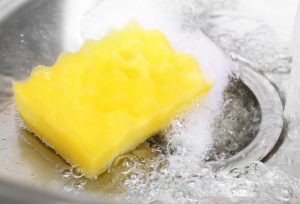
Kitchen sponge is a very useful item in the kitchen. It’s always at hand when a cup needs a wash, or when juices form our delicious lunch spill on the benchtop. It helps us maintain everything clean and healthy. Or does it?
The reality is that when used for a longer time, the kitchen sponge becomes infused with germs, including faecal or poop bacteria. These are being transmitted to the dishes that are cleaned with the sponge, including your coffee mug.
Some tests have found that an average sponge will have bacteria like E. Coli and Salmonella within 3 weeks of use. Over 350 different species of bacteria were discovered living inside the sponge, and the density of bacteria reached up to 45 billion per square centimetre.
| TIP | Kitchen sponges or dishcloths should not be used to wipe food spillages or remnants. For such clean-ups it’s best to use paper towel that can be disposed of. The best practice is to replace kitchen sponges every 1-2 weeks in high traffic places. Also, every few days the sponge can be disinfected by popping it into a dishwasher with heated dry cycle or microwave it on full power. |
FRIDGE
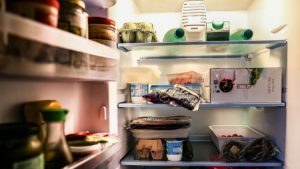
Fridges are another bacterial meet-up spot both outside and inside. While the fridge handle is enjoying the attention of many hands throughout the day, there’s another type of party taking place on the inside.
Employees will often bring lunch to work, but also many times they will forget to finish their food and leave the leftovers sit inside the fridge for days.
This is where the yeast and mould get down to work. These “spoiler organisms” will break down the food that is past it’s use-by date and release their spores to contaminate other food items, turning the fridge into a haven for bacteria. So much so in fact that some studies have even concluded you’d be better off storing your lunch in the staff washroom.
| TIP | Remind the employees to store their food in plastic containers with a tight-fitted lid, a plastic wrap or foil. If they bring raw food to work, this should be placed on the bottom shelf to prevent contamination. Set the fridge temperature to 4⁰C or lower, to slow down the growth of bacteria: Bacteria grow the fastest at a temperature between 5⁰C and 60⁰C. Finally, a thorough clean of the fridge should be organised regularly, preferably every 1-3 months, or even more frequently in large workplaces. |
MICROWAVE
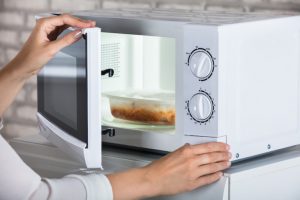
Much like the fridge, microwave oven is a best friend to many office “lunchers”. But you may be surprised to learn that the heat from the microwave used to heat up your lunch will not sterilise a dirty oven.
The walls of the microwave oven simply do not get heated to the point that can kill bacteria. On the contrary, the food bits and spillages that stay behind will only help the bacteria grow even more, especially bacteria such as E. coli and Salmonella.
| TIP | Any food splatters or remnants inside a microwave should be immediately removed, and the oven thoroughly cleaned and disinfected on a daily basis. Make sure that your cleaning service provider is doing this regularly on each visit, including sanitising the door handle, knobs and buttons. |
PHOTOCOPIER

This unassuming object, oftentimes hidden away from sight in a dark corner is by no means a recluse. Quite the contrary, the photocopier’s social life is probably more active than yours. Many hands and digit fingers will be lifting up the cover and pushing the start button on a daily basis. Moreover, thanks to its discrete nature, it is oftentimes overlooked during a routine clean. No wonder the photocopier crawls with germs.
As per a microbiology test performed on the copier start button, this tiny surface alone can carry over 186 million colony forming units per square centimetre.
| TIP | Keep antibacterial wipes close to the photocopier and encourage employees to use them occasionally to wipe off the surfaces. Also, make sure that your cleaning service provider is wiping and disinfecting these surfaces at least once every week. |
WATER COOLER

Imagine a group of people standing around the water cooler and chatting. You would think that only the tap is exposed to an overbearing amount of pathogens, but in fact germs expelled from the human mouth are being spread all over and around the water cooler.
Germs can land just anywhere, even on the spout. If we consider that some people like to shove their plastic bottles right up the spout to fill them up, we end up with a perfect concoction of germs only waiting to find a new host.
| TIP | Daily cleaning and disinfecting of the water cooler should be on top of the to-do list. When cleaning the cooler, the drip tray should also be properly wiped and dried. The constantly wet environment of the drip tray is a favourite breading ground for bacteria. Every time you place a cup onto the tray while pouring water, the bacteria is transferred to the cup and other surfaces that the cup will touch thereafter. |
FUN FACTS:
-
-
-
- Human hands on average have about 1 500 bacteria per square centimetre at any one time. Every time you touch and object or shake someone’s hand, you are most likely collecting bacteria and even viruses. The average adult is said to touch daily around 7 200 surfaces and their face between 384 and 552 times.
-
-
-
-
-
- The most obvious among the high-touch points are the door handles, light switches, elevator buttons and handrails. Needless to say, these surfaces are home to plenty of germs that originate from outside the workplace as well as from people’s bodies.
-
-
-
-
-
- The average mobile phone contains 10 times more bacteria than the average toilet seat. We rarely remember to clean our phones without realising that the warm environment our phones provide is a perfect breeding ground for the germs. And considering how often we use our phones, they tend to stay warm throughout the day. Landline phones are not much different especially when shared by employees. About 300 bacteria per square centimetre can be found on the phone receiver.
-
-
-
-
-
- Kitchen sponge can be sterilised in a microwave oven, when done properly. Soak the sponge in water before placing it inside the microwave. Turn on the microwave on full power for 4 minutes. A research showed that 99% of all the living pathogens are killed within 2 minutes, while some bacteria may take 4min.
-
-
-
-
-
- In a scientific research, the toilet seat consistently had the lowest bacteria levels of all the tested high-touch surfaces, approximately 50 bacteria per square centimetre. Why is that so, you may ask? People are aware of what’s going on in the bathroom and generally maintain better hygiene in this area.
-
-
-
-
-
- When flushing the toilet with the lid up, microscopic bacteria from your ‘business’ are ejected into the air where they can stay for up to 6h and land on any surface in the toilet cubicle and bathroom. Still wondering how poop germs ended up on your coffee mug?
-
-
-
-
-
- Paper towel are more hygienic than hand dryer. The hot air or jet air flow helps to spread germs from the washroom air and does more harm than good. You may want to wash your hands again after drying them.
-
-
Cleanaux is a cleaning service provider committed to delivering high-standard cleaning services and maintaining your workplace fresh and safe for all its occupants and visitors. Contact us for a free consultation, to schedule a visit of your workplace, and to receive an obligation-free quote: 1300 277 009 or info@cleanaux.com.au
